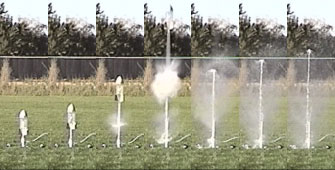What is “Lil’ Champ”?
Lil’ Champ is the name of a rather ugly 1-liter rocket I made. I am featuring it here because of how well this type of rocket performs. The picture below essentially shows you the materials and methods of construction. Basically, create a big foam mess by cutting up a foam football with a sharp blade, then glue what's left to the top of a streamlined seltzer-water bottle. Then glue four corrugated-cardboard fins symmetrically around the tail using Goop™ glue. Pretty simple stuff.

How well does it do?
Quite well. The flight time was almost exactly 10 seconds, which means the rocket went about 120 meters high. This is not bad when you consider that the rocket did this at an air pressure of only 6.9 bar (100 psi). Below is shown a sequence of launch photos, 1/60 second apart. You can see clearly how the water column “chases” after the rocket, one of the fun observations about water rockets.
Click on the above image to play the 516KB DivX-encoded AVI file. The movie runs natively at 60 frames per second, but can be played at slower speeds using a player such as Irfanview.
What does the simulator say?
I tried to reproduce the flight by putting some numbers into Sim Water Rocket, my simulator applet. Here are the most important input values:
- Rocket mass = 84 g
- Bottle diameter = 8.95 cm
- Nozzle adjusters = 50, 27, 50
- Rocket volume = 1.11 L
- Water volume = 0.25 L
- Gas pressure = 6.9 bar
- Launch-tube length = 19.7 cm
- Launcher volume = 0.15 L
In order to fit the simulation to the video data I used CD = 0.15, which is a surprisingly low drag coefficient when compared to other soda-bottle rockets. However, it is a plausible value because, under the right conditions of a turbulent boundary layer, spheres can have CD as low as 0.1. The aerodynamic efficiency of this rocket is the big reason it goes so high. It turns out that the natural mass of this rocket and the amount of water I used are very nearly optimal to maximize apogee height.
The simulator predicts that the maximum acceleration of the rocket during the 70-millisecond boost is 289 G. At the end of the boost the velocity is 74 m/s (166 mph). Amazing!

